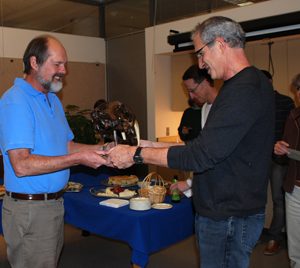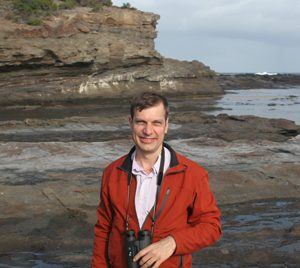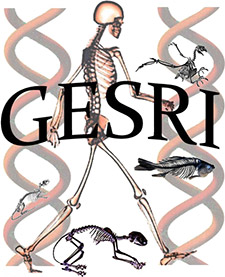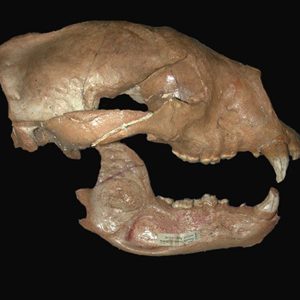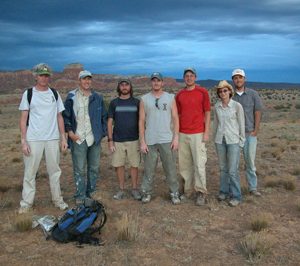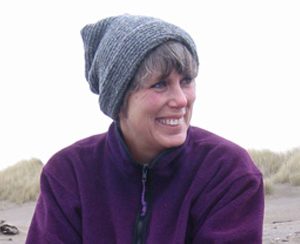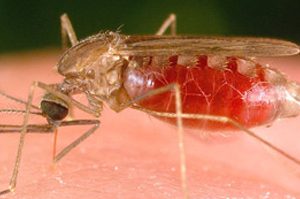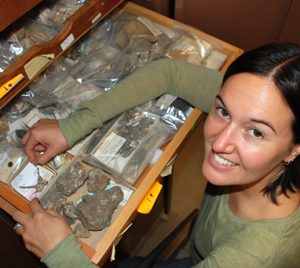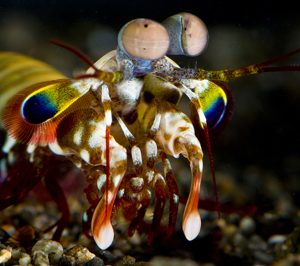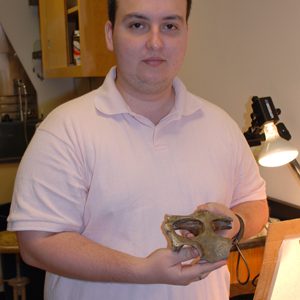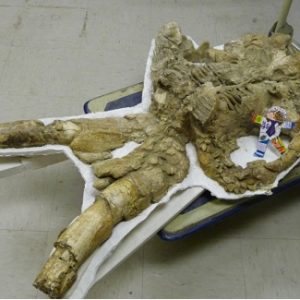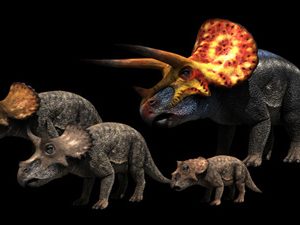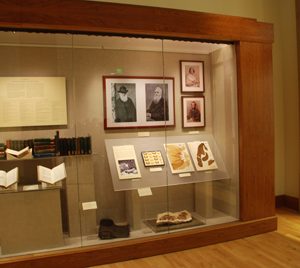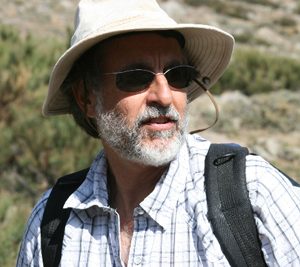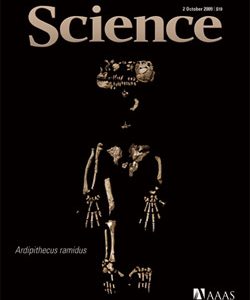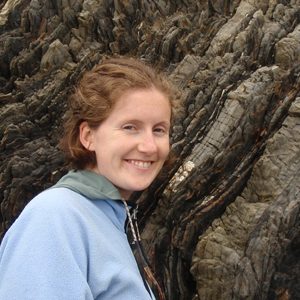At the close of 2009, Roy Caldwell stepped down from his position as UCMP Director. Thankfully, Roy isn't going anywhere — he will continue to be a Faculty Curator at the museum and a professor in the Department of Integrative Biology. Roy became the interim director in 2005 and director in 2006. Says Roy, "Acutely aware of my lack of training and experience as a paleontologist, the most I could hope for was to be a facilitator — and hope that I didn't muck things up. Judging by the high quality … [Read more...] about Thank you, Roy Caldwell!
Latest News
Welcome Charles Marshall, new UCMP Director!
Let’s give a great, big UCMP welcome to Charles Marshall — the new Director of the UCMP! Charles recently joined the faculty of the Integrative Biology department after being on the faculty at Harvard as well as being the curator of invertebrate paleontology at Harvard’s Museum of Comparative Zoology. "Greetings to all members and friends of UCMP," says Charles. "I am very excited to be part of UCMP and look forward to meeting you all, and in joining you as we work to make UCMP an even … [Read more...] about Welcome Charles Marshall, new UCMP Director!
Genetics and Evolution of the Skeleton Research Initiative conference
The Genetics and Evolution of the Skeleton Research Initiative recently had its semiannual meeting in San Francisco. Organized by UCMP Faculty Curator Leslea Hlusko, the focus for this year’s meeting was Development, Diseases, and Evolution of Mineralized Tissues. Two graduate students from the Hlusko lab, Theresa Grieco and Sarah Amugongo, give us these snapshots from the conference: Highlights from the conference, by Theresa Grieco: The GESRI meeting draws bone biologists from all over the … [Read more...] about Genetics and Evolution of the Skeleton Research Initiative conference
Fossils provide baseline for mammal diversity
As more and more species go extinct, biologists wonder whether we are on the verge of the earth's sixth mass extinction. A new study, by Marc Carrasco and Tony Barnosky of the UCMP and Russell Graham of Pennsylvania State University, uses the fossil record to examine mammal biodiversity in North America over the past 30 million years. Carrasco and his collaborators used data from two fossil databases, MioMap and Faunmap, to determine the baseline of mammal diversity before humans arrived in … [Read more...] about Fossils provide baseline for mammal diversity
New dino described by UCMP alums
Last week, two University of California Museum of Paleontology alums, Sterling Nesbitt and Randall Irmis, described a new species of dinosaur in the journal Science. The new species, Tawa hallae, sheds light on early dinosaur evolution — and the importance of the UCMP's collections. Tawa's bones were first found by hikers in Ghost Ranch, New Mexico, in 2004. Around that time, Sterling and Randy were doing fieldwork at the nearby Petrified Forest National Park in northern Arizona, excavating … [Read more...] about New dino described by UCMP alums
Ardi is Breakthrough of the Year
Ardipithecus ramidus has been named Science magazine's Breakthrough of the Year. At 4.4 million years old, Ardi is the oldest hominid skeleton. This fall, a series of 11 papers about Ardi and her paleoenvironment were published in Science. UCMP Faculty Curator and Human Evolution Research Center (HERC) director Tim White was one of the lead scientists on the project, which involved an international team of researchers, including UCMP Faculty Curator Leslea Hlusko. To learn more about Ardi, … [Read more...] about Ardi is Breakthrough of the Year
Judy Scotchmoor named AAAS Fellow
Congratulations Judy Scotchmoor, UCMP Assistant Director for Education and Public Programs! Judy was named an American Association for the Advancement of Science (AAAS) Fellow. Judy receives this prestigious award "for leadership in defending teaching of evolution and quality science education through nationally recognized websites on these issues and through leadership of Coalition on the Public Understanding of Science." The websites, for which Judy is project coordinator, include The … [Read more...] about Judy Scotchmoor named AAAS Fellow
Evo in the news: Fighting the evolution of malaria in Cambodia
Evolution doesn't just happen in a textbook — evolution is happening right now, and one example is the pathogen that causes malaria. Malaria kills nearly one million people each year. The disease can be treated, but new drug-resistant strains of the pathogen, Plasmodium falciparum, have recently been discovered in western Cambodia. These strains are resistant to artemisinin, the most effective anti-malarial drug available. Learn more about the evolution of drug resistant malaria pathogens, and … [Read more...] about Evo in the news: Fighting the evolution of malaria in Cambodia
No backbones allowed
The UCMP Invertebrates Collection includes over 31,000 catalogued specimens! Corals, crabs, bivalves, snails, ammonites… both fossil and recent — if it doesn't have a backbone, it's in this collection. I am a UCMP and Integrative Biology graduate student and have been assisting with curation of the Invertebrate Collection. I catalogue and label specimens, process loan requests, manage the Invertebrates Collection database, curate private collections that are donated to the UCMP, and do numerous … [Read more...] about No backbones allowed
Evo in the news: Oxygen as an evolutionary constraint
Evolution is everywhere — including in the news! That's why each month we publish a new Evo in the News feature on our Understanding Evolution website. This month, we focus on oxygen as an evolutionary constraint. When life began 3.5 billion years ago, all organisms were tiny. Today, earth has some pretty big inhabitants, like the blue whale and the giant sequoia. Learn how the amount of oxygen in the atmosphere opened the door for the evolution of these big organisms. Read the latest Evo in the … [Read more...] about Evo in the news: Oxygen as an evolutionary constraint
Paleo Video: A modern day dinosaur extinction
During the Cretaceous, dome-headed pachycephalosaurs roamed through what is now the Hell Creek Formation, covering parts of Montana, Wyoming, and North and South Dakota. But UCMP Curator Mark Goodwin and Museum of the Rockies Curator Jack Horner argue that there were fewer pachycephalosaur species than we thought. Mark and Jack suggest that two species, Dracorex hogwartsia and Stygimoloch spinifer, are actually juveniles and teenagers of the species Pachycephalosaurus wyomingensis. Learn about … [Read more...] about Paleo Video: A modern day dinosaur extinction
Stomatopods and DVDs
Sometimes, the study of basic biology can lead to technological advances, and a recent discovery about the vision of mantis shrimp is a perfect example, providing insight that could help us improve the technology inside DVD players. What is the connection? Circularly polarized light! You're probably familiar with linearly polarized light. Fishermen often wear polarized sunglasses to reduce the glare from the water and make it easier to see the fish. Typically a ray of light vibrates randomly in … [Read more...] about Stomatopods and DVDs
South American crocodilians
Daniel Fortier visited the UCMP for two weeks this summer, investigating the taxonomy of South American crocodilians — crocodiles, caymans, and gharials. Daniel is from Brazil, where crocodiles are fairly common. He is a Ph.D. student at the Universidade Federal Do Rio Grande Do Sul in Porto Alegre, and is spending the year at the University of Iowa, in Iowa City. He is using fossils and modern skeletal materials to learn about crocodilian evolutionary history, places of origin, dispersal … [Read more...] about South American crocodilians
Flat Stanley visits the UCMP
The UCMP has hosted several Flat Stanleys this year, as part of the Year of Science 2009. Flat Stanley is a fictional character from a children’s book, written by Jeff Brown in 1964. In the original story, Stanley is a little boy who is flattened when a bulletin board above his bed falls on top of him. He finds that, in his new flattened state, he is able to have many great adventures by being mailed from place to place in an envelope. Inspired by this story, the Flat Stanley project began as a … [Read more...] about Flat Stanley visits the UCMP
Dinosaurs decoded
UCMP Assistant Director Mark Goodwin's research on Triceratops is featured on National Geographic Channel's video of the week. Triceratops are named for the three horns that protrude from the skull — and as Mark and his colleague Jack Horner have discovered, those three horns tell a fascinating story about the growth and development, and potentially the behavior, of these dinosaurs. The National Geographic video is an excerpt from an hour-long television program, Dinosaurs Decoded. Be sure to … [Read more...] about Dinosaurs decoded
The Bancroft Library’s Darwin exhibit
UCMP and the other Berkeley Natural History Museums are well represented on a new exhibit in the Bancroft Library — Darwin and the Evolution of a Theory. We had a special tour of the exhibit last week thanks to UCMP Faculty Curator – and exhibit co-curator – Kevin Padian. The exhibit is stunning. There are rare books and manuscripts from the Bancroft Library and other campus collections, as well as numerous specimens, including a South American ground sloth fossil from the UCMP, Galapagos … [Read more...] about The Bancroft Library’s Darwin exhibit
UCMP’s Tony Barnosky in The Economist
Check out this week's issue of The Economist — it features the work of UCMP Faculty Curator Tony Barnosky. Tony looks at how climate change affects the ecology and distribution of mammals — in the distant past and in the future. The UCMP last blogged about Tony's work here. … [Read more...] about UCMP’s Tony Barnosky in The Economist
Human evolution in the headlines
This week's big paleo story centers on Ardipithecus ramidus, a species of hominid that lived in the woodlands of Ethiopia, 4.4 million years ago. UCMP Faculty Curator and Human Evolution Research Center (HERC) director Tim White is co-director of the Middle Awash Project, the team of researchers that excavated and studied the fossils. The team includes UCMP Faculty Curator and HERC Associate Faculty member Leslea Hlusko. Find out more about the discovery: Science magazine has 11 papers … [Read more...] about Human evolution in the headlines
Uncovering the hidden hazard of hairspray what is the connection to the UCMP?
Well, hairspray is not really the focus of this article, but the process of science IS, and that explains its connection to the UCMP! With all of the efforts on our Understanding Evolution website, it did not take long before it became apparent to us that much of the confusion about evolution is linked to confusions about science itself – how it works, what it is, what it is not, and what is not science. In response, UCMP pulled together an astonishing set of advisors and launched a new website … [Read more...] about Uncovering the hidden hazard of hairspray what is the connection to the UCMP?
Paleo Video: Kaitlin Maguire at the John Day Fossil Beds
Watch this video and join UCMP graduate student Kaitlin Maguire on a field trip to the John Day Fossil Beds National Monument! After visiting the park last spring, Kaitlin decided it's the perfect place to do her dissertation research. "When you do a field project for paleontology, especially if you're looking for fossils, you never know what you're going to find — you never know if there's going to be enough data," says Kaitlin. But paleontologists from the UCMP and elsewhere have been … [Read more...] about Paleo Video: Kaitlin Maguire at the John Day Fossil Beds
